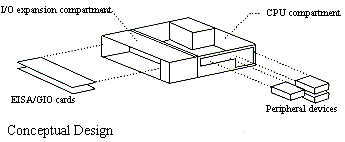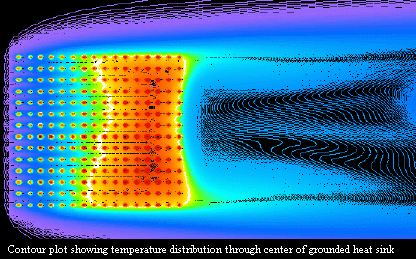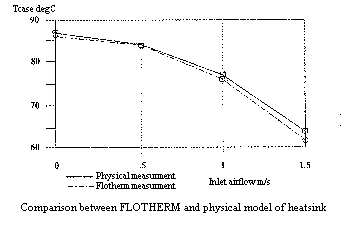Silicon Graphics Indigo 2 Workstation
日期:2012-06-20
Thermal Design of the Silicon Graphics
|
|
The Silicon Graphics Indigo 2 Workstation is a UNIX system based around the MIPS family of high speed RISC microprocessors The electronics hardware and main peripheral devices are packaged in a sheet metal and injection molded plastic enclosure. The unit is air cooled and meets FCC class A requirements.
The Indigo 2 system needed to meet numerous technical and manufacturing design criteria, and was constrained by usability factors Those directly impacting the thermal management scheme were: 400W total power dissipation; low noise emission of 33-36Db(A) at room temperature; low cost; desktop form factor; FCC class A compliance; and modular user-serviceable parts.  Physical Model Physical Model
Initial conceptual design forced a separation between the CPU section and the I/O expansion card cage, allowing separate physical models to be constructed. Early foam core cardboard models with resistive load boards were later replaced by sheet metal, functioning board sets and injection molded plastic parts. Critical high speed gate arrays and microprocessors (4 to 20W) were constructed using flat pack resistors within hollow ceramic PGA bodies approximating the real packages allowing case temperature measurements to be made.
A succession of FLOTHERM models were developed during the prototype design phase and modified in conjunction with the physical models. Modification could be made rapidly, allowing concurrent numerical and physical modeling. The detailed flow fields produced provided a better understanding of the way each configuration was performing, doubling the effectiveness of the modelling process.  Analysis Performed on CPU Compartment Analysis Performed on CPU Compartment
Much of the design effort focused on the CPU compartment. The Indigo 2 architecture allows for the CPU core to be placed on a daughter card. The removable module allows the user to upgrade the system as successive generations of microprocessors become available. The design goal was to provide heat transfer capacity for 100W, requiring an estimated 1.5m/s airflow.

The FLOTHERM predictions for heat sink performance were compared to case temperature measurements, and a good agreement was obtained.
Having built up confidence in the FLOTHERM modelling of the heat sink performance, it was possible to evaluate a different heat sink design every day, whereas a 10-day cycle was needed for a machined aluminium part at considerable cost. The Indigo 2's I/O expansion to the main CPU is based on the EISA standard of four slots, to take Silicon Graphics GIO cards which have nearly the same form factor as standard EISA cards. These cards produce 50W, much of which is concentrated in dense, high speed ASICs, clock devices amd MCMs (range 2 - 7W), whose performance is temperature-sensitive.
Similarly to the CPU compartment a 1 m/s airflow over each card was expected to provide adequate cooling. To achieve this the expansion cage required its own fan. As the card locations were predetermined from electrical considerations, the thermal design work consisted of optimizing the air flow. This focused on flow direction, fan position and vent details. The Silicon Graphics Indigo 2 workstation was developed over a period of about 18 months from conception to production of deliverable units. At the time of the product's conception it was clear that simulation, both electrical and mechanical, would play a major role in keeping up with aggressive design schedule. The parallel usage of both physical modelling and computational fluid dynamics modelling of the system enclosure was instrumental in providing a sound mechanical design for thermal management The final prototype workstation passed through all thermal design verification testing without fault, avoiding the need for redesign which would have caused the product to miss its manufacturing release date. The Indigo 2 is planned to be manufacture by Silicon Graphics for about three years before another generation of workstation displaces it. During this period a series of hardware upgrades and third-party hardware will be developed for the product. A finalized global FLOTHERM model will be available for use by future hardware developers. This detailed model will aid in component placement and overall board layout. The methods of simulation presented here show that it is highly beneficial to follow a combined program of both physical and numerical simulation of enclosure thermal characteristics during the design process. 
Based on the success of the Indigo 2 project, all future products designed by the Interactive Systems Division at Silicon Graphics will rely heavily on Computational Fluid Dynamics simulation followed up with thorough physical modeling of promising configurations. This paper was presented by its author, Chris Wheaton of Silicon Graphics, at the 2nd International FLOTHERM User Conference held in Boston, MA, 1993 |









 沪公网安备 31010602003953号
沪公网安备 31010602003953号